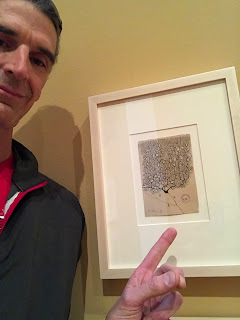Stuff I Learned; staycation
This past week I reveled in the joy of the staycation. While the days were relatively full, I enjoyed longer workouts, time with family, and even a quick trip to Minneapolis. I am happy to report that I'm starting to feel ready to resume my UW coursework tomorrow morning. Yes, there are a few pages that I should read this afternoon, along with the omnipresent voice in my head that recommends working on my academic writing... though by and large, I'm feeling ready to bring it on in terms of the remainder of the Spring semester.
This semester has been dominated by Systems Neuroscience (Systems), which has been one of the most interesting courses that I've ever taken. This 4-credit course has required 20-25 hours per week of studying. Despite the significant time requirements, Systems has opened doors to the universe that's within our brains. I often feel like a little kid that's just starting to see the big-ness and wonder of the world when I learn more about the brain. I'm just scratching the surface in neuroscience, and already, I'm feeling drawn into the vastness of this field. While I feel self-conscious using the term universe within, I cannot think of a more apt term in describing the field of neuroscience.
What did I learn? As I reflected on writing this blog posting, the material that I learned over the past nine weeks doesn't lend itself all that well to a descriptive treatment. For example, the class spent a good deal of time on neuroanatomy. If you give me a slice of a brainstem, there's a pretty good chance that I can identify the various parts and pieces. But try as I may, I could not arrive at a pithy (and yoga-related) discussion of the blobs, pyramids, olives, ambiguus nuclei or the calyx of Held. (yes, these are all real terms for real parts of the brain).
With the technical details of neuroanatomy as a foundation, it does seem as though Systems is going to pivot a direction that more directly lends itself to interesting discussions in this blog. The next two weeks will be spent studying brain structures that are related to movement (the basal ganglia and cerebellum), followed by one month studying learning, memory, motivation and emotion. I am very excited by the forthcoming material, and much of this afternoon's reading will involve getting a head-start on the coming week's discussion of movement. I look forward to sharing what I learn!
Sorry for the long gap since I last wrote - I hope to write more regularly over the remaining 6-weeks of Spring semester.
This semester has been dominated by Systems Neuroscience (Systems), which has been one of the most interesting courses that I've ever taken. This 4-credit course has required 20-25 hours per week of studying. Despite the significant time requirements, Systems has opened doors to the universe that's within our brains. I often feel like a little kid that's just starting to see the big-ness and wonder of the world when I learn more about the brain. I'm just scratching the surface in neuroscience, and already, I'm feeling drawn into the vastness of this field. While I feel self-conscious using the term universe within, I cannot think of a more apt term in describing the field of neuroscience.
 |
| Purkinje cells of the cerebellum by the great scientist/artist Cajal. |
With the technical details of neuroanatomy as a foundation, it does seem as though Systems is going to pivot a direction that more directly lends itself to interesting discussions in this blog. The next two weeks will be spent studying brain structures that are related to movement (the basal ganglia and cerebellum), followed by one month studying learning, memory, motivation and emotion. I am very excited by the forthcoming material, and much of this afternoon's reading will involve getting a head-start on the coming week's discussion of movement. I look forward to sharing what I learn!
Sorry for the long gap since I last wrote - I hope to write more regularly over the remaining 6-weeks of Spring semester.



Comments